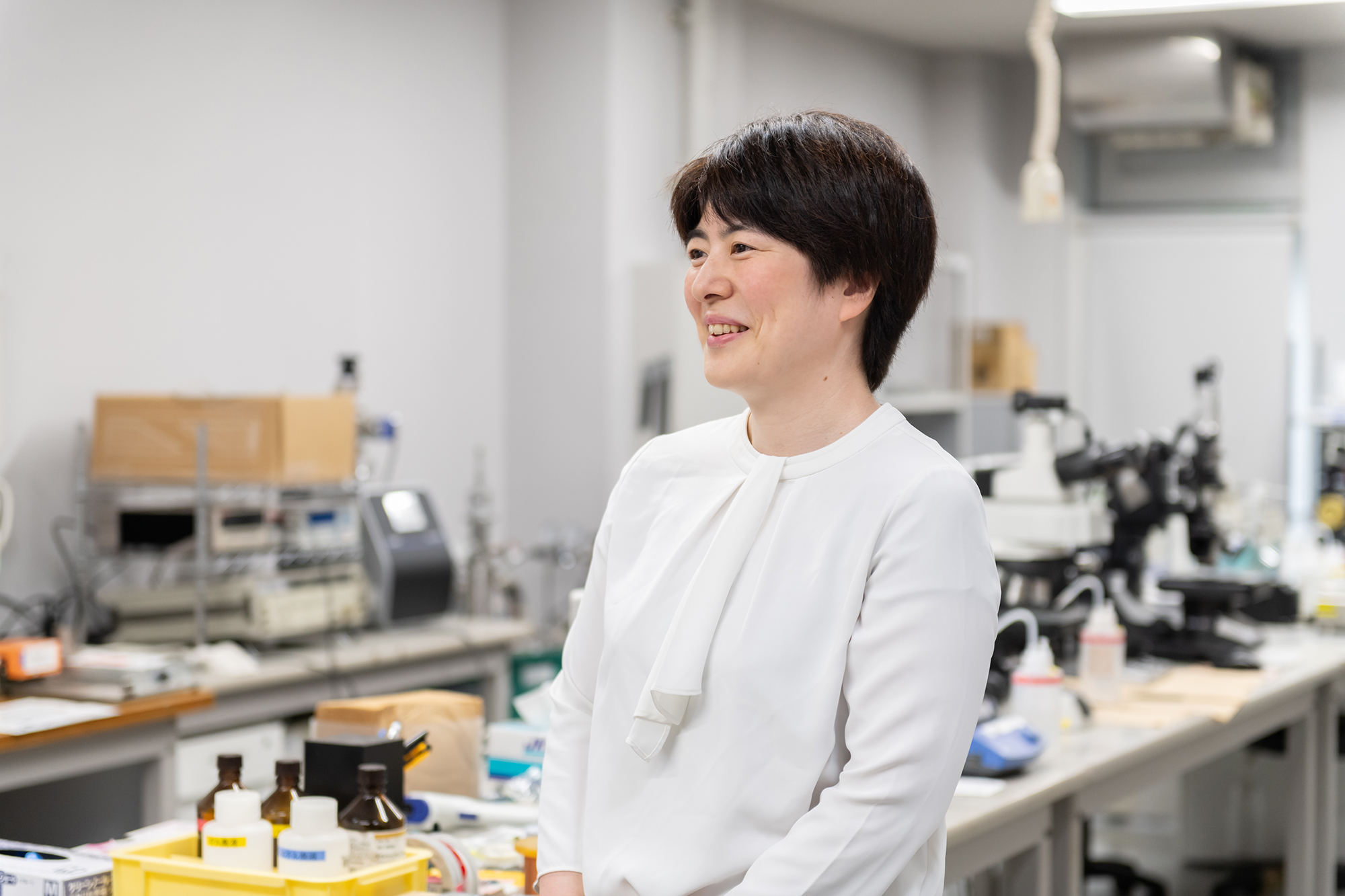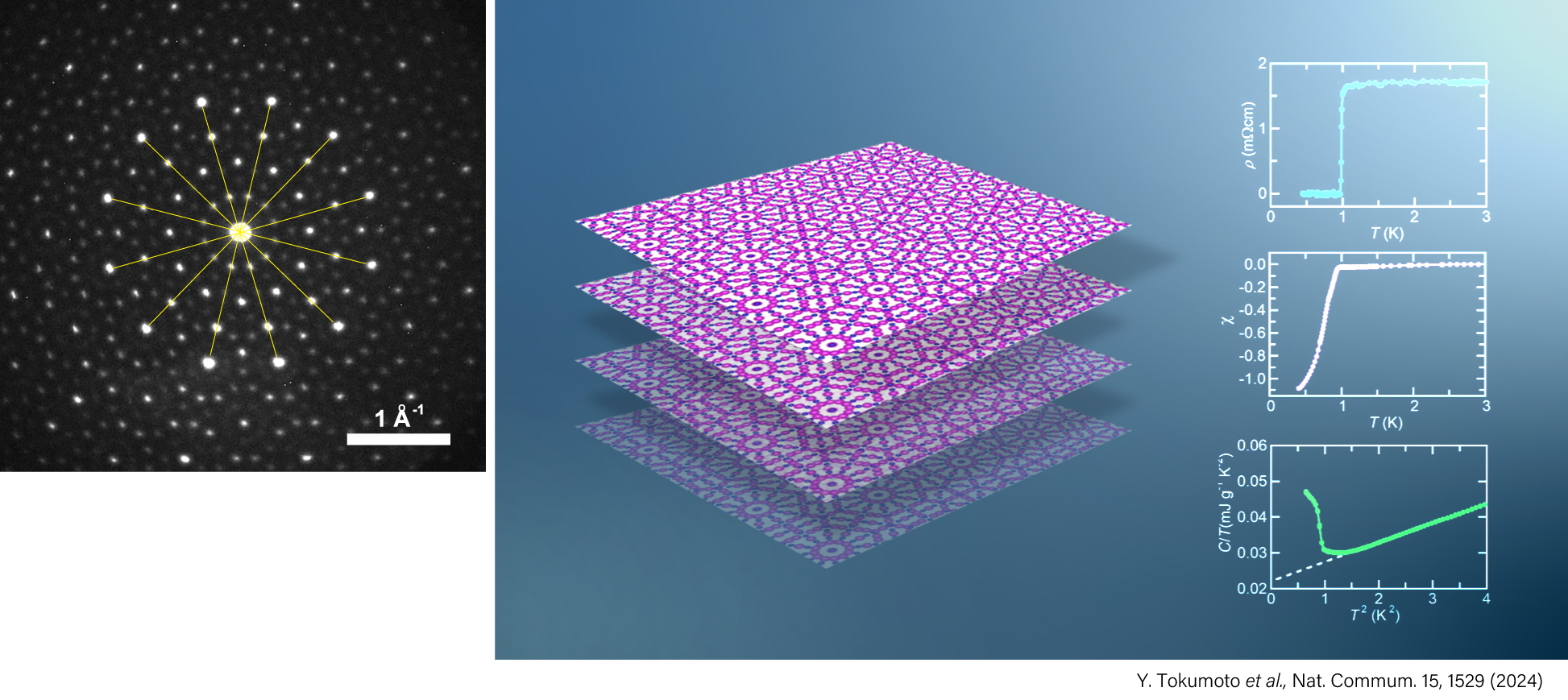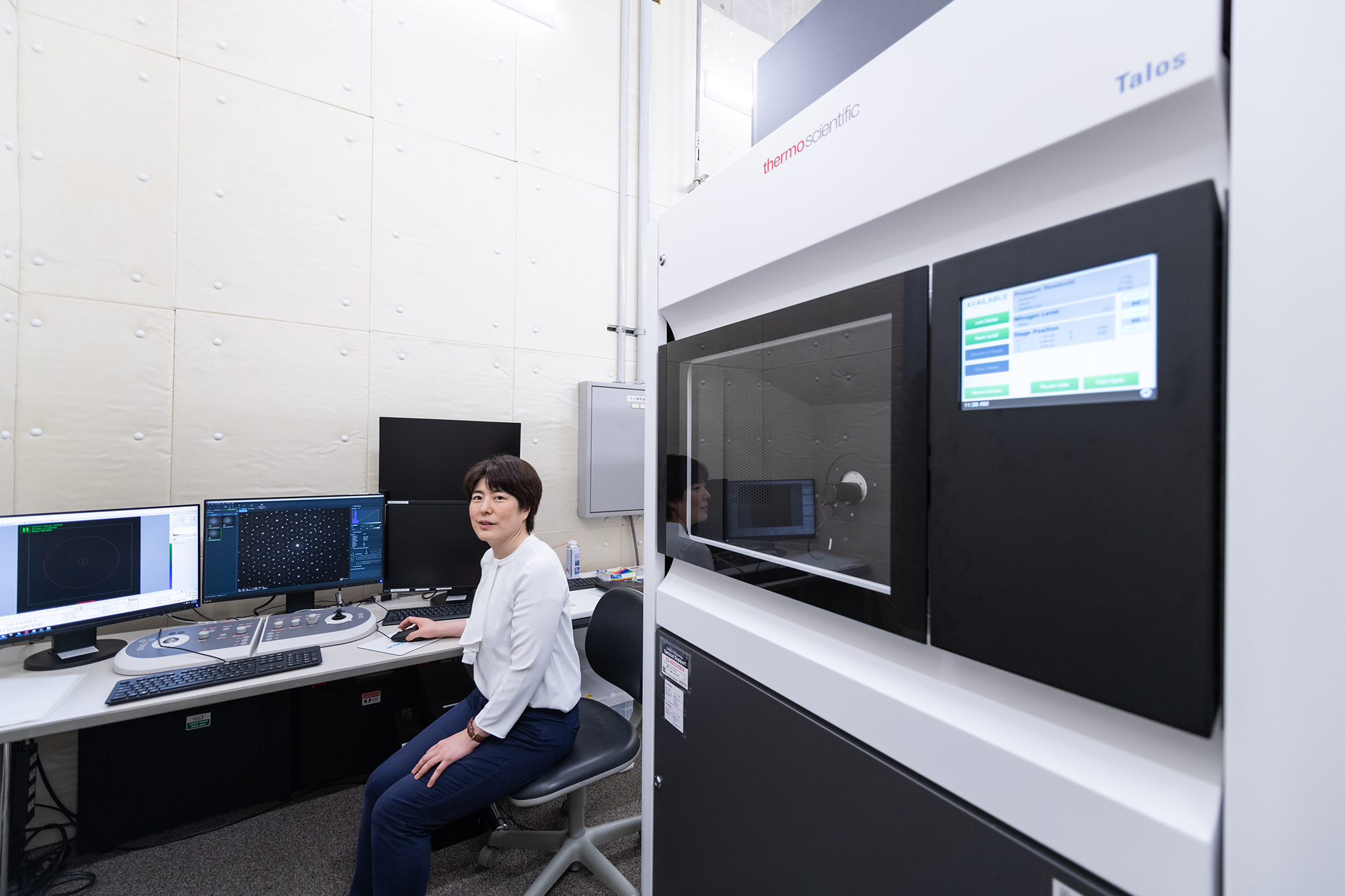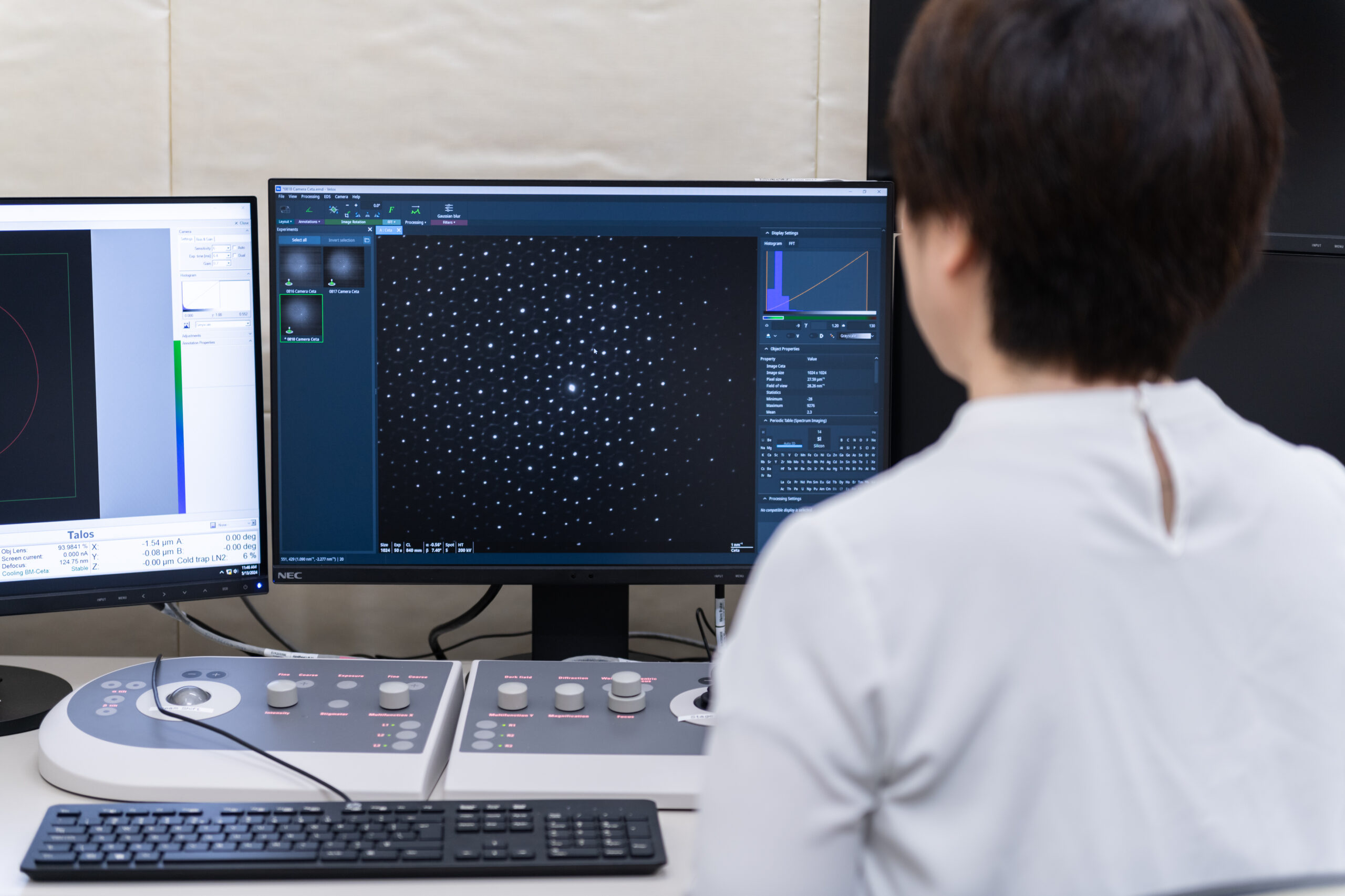Newly discovered superconductivity in quasicrystals, a third class of solids
To identify the unknown properties hidden in solid-state materials

Solids can be divided into three groups depending on their structure. Crystalline solids have atoms that have a periodic arrangement. Amorphous solids have atoms that are arranged with no definite form. And, lastly, quasicrystals, which differ from either of these two groups. Among these, we have only come to know about the existence of quasicrystals relatively recently, and their properties are still not well known. While researching a quasicrystal categorized as van der Waals layered quasicrystals, Yuki Tokumoto, Lecturer at the Institute of Industrial Science, The University of Tokyo, discovered that the quasicrystal have superconductivity. We spoke with Tokumoto about the meaning of this world’s-first discovery and expectations for future development.
From research that began three years ago to a world’s first discovery
On March 1, 2024, “Superconductivity in a van der Waals layered quasicrystal,” was published in Nature Communications at DOI: 10.1038/S41467-024-45952-2.
Led by Lecturer Yuki Tokumoto, it was a presentation on a joint discovery by the UTokyo-IIS group and the Tokyo University of Science group on a quasicrystal material (a type of van der Waals layered quasicrystal) exhibiting superconductivity. What exactly is this discovery, which represents multiple “world firsts”? Let’s take a look back at the history of Tokumoto, who was the driving force behind this discovery.
For quite some time, Tokumoto has been researching the dislocations that occur in crystals. Dislocations are linear defects that occur inside a crystal when the crystal is subjected to external forces.
“There’s a negative image of them having defects, don’t you think? It is, in fact, better for there to not be any dislocations when utilizing the properties of the crystal itself. However, on the other hand, the presence of such defects can lead to the discovery of physical properties that would otherwise be impossible to obtain in a perfect crystal. I found this interesting, and have since continued to research dislocations.”
After completing graduate school, Tokumoto served as an assistant professor at Tohoku University for four years before joining UTokyo-IIS as a lecturer in 2013. Tokumoto has since continued to research dislocations and began researching van der Waals layered quasicrystals from around 2021. Tokumoto recalls that it was a suggestion by Professor Keiichi Edagawa that set Tokumoto on this path. Professor Edagawa taught students with her and was an expert in the field of quasicrystals.

What is this third class of solids, quasicrystals?
Solids can be divided into three groups depending on their structure: crystalline, amorphous, and quasicrystal. The atoms of a crystal have an periodic ordered arrangement while the atoms of an amorphous material have no definite form. A quasicrystal is a third class of solid that is different from either of these. Although quasicrystals do not have translational symmetry (parallel and overlapping) like crystals, they do have long-range order (a certain regularity). In other words, quasicrystals have a different regularity from that of crystals.

Image: Lecturer Yuki Tokumoto
Quasicrystals were discovered by Dr. Daniel Shechtman in 1984. However, at the time, it was a concept that struggled to find acceptance because it was contrary to the common understanding of solids. Even a famous chemist who won the Nobel Prize denied it, saying, “There is no such thing as quasicrystals.” However, as several high-quality quasicrystals were subsequently discovered, its existence became certain, and the discoverer, Dr. Shechtman, was awarded the Nobel Prize in Chemistry in 2011.
In 2012, a quantum critical phenomenon (a phenomenon in which the quantum mechanical state changes near absolute zero) was observed in quasicrystals. This differs from the quantum critical phenomenon observed in crystals, representing the discovery of a phenomenon only observed in quasicrystals. Amid increasing research on the physical properties of quasicrystals, the manifestation of superconductivity in quasicrystals was first discovered in 2018.
Discovery of superconductivity in quasicrystals and three remaining issues
Superconductivity in quasicrystals was first discovered by a group at Nagoya University. Superconductivity is generally known for the property of zero electrical resistance. However, in reality, it is also necessary to confirm the presence of large diamagnetism and jumps in specific heat. For the first time, the group succeeded in confirming these properties in quasicrystals. As a side note, the material used was a quasicrystal of an aluminum-zinc-magnesium alloy.
Since then, theoretical research on superconductivity in quasicrystals has progressed, and various superconducting properties unique to quasicrystals have been demonstrated theoretically. However, such properties have not been verified experimentally. This is because there are still challenges that must be overcome to conduct such validation.
“Although superconductivity in quasicrystals was discovered in research in 2018, it was difficult to experimentally verify the unique superconducting properties of quasicrystals shown in subsequent theoretical research. There were three problems with quasicrystals researched by a group at Nagoya University: the sample size was too small, there was a lack of thermodynamically stability, and the temperature at which they transitioned to superconductivity, 50 millikelvin, was extremely low. As such, there was a need to observe superconductivity in quasicrystals that cleared these hurdles, and in this background I advanced research on quasicrystals whose physical properties had not been studied much thus far.”
Reason for choosing van der Waals layered quasicrystal
Tokumoto chose a quasicrystal alloy system comprised of tantalum and tellurium. This is classified as a “two-dimensional quasicrystal” and has a plane (layer) with a structure in which tantalum and tellurium are arranged quasi-periodically. The plane has a layered structure due to the weak force called van der Waals force. Two-dimensional layers stacked together by van der Waals forces are called “van der Waals layered materials.”
“It is known that when the number of layers of van der Waals layered materials is reduced to three, two, or even a single layer, the electronic structure differs completely compared to a state in which many layers are stacked. This can result in interesting physical properties. It is also possible to twist and stack monolayers, or to stack a monolayer of one material on top of another, providing new physical properties. Van der Waals layered materials are currently being researched actively in the field of condensed matter science for their infinite potential for expressing new properties.”
The tantalum-tellurium quasicrystal that Tokumoto worked on is the only van der Waals layered material among the currently known quasicrystals. Expecting some unique physical properties, Tokumoto worked on synthesizing and measuring the physical properties. It was after roughly two years that Tokumoto discovered that the material exhibits superconductivity.

Bulk superconducting transition observed at Tc~1 K. The second example of superconductivity in quasicrystals, and a first in thermodynamically stable quasicrystals!!
Image: Lecturer Yuki Tokumoto
“This is the second time that superconductivity has been discovered in quasicrystals, following the discovery by the Nagoya University group mentioned earlier, and the first time for thermodynamically stable quasicrystals. It is also significant that the van der Waals layered quasicrystal exhibits superconductivity at a temperature of 1 Kelvin, approximately 20 times higher than the first example in 2018 (50 millikelvin). This is a world’s first discovery of such properties in the van del Waals layered quasicrystal. As for the experimental validation of this theory, we were able to clear two of the three challenges, but still the issue of sample size remains. I would like to make larger samples and conduct more experiments to overcome this problem.”
The potential beyond this discovery
This discovery is expected to contribute to clarifying the mechanism of superconductivity in quasicrystals. While there may not be immediate applicability, Tokumoto’s words convey that great untapped potential lie beyond this discovery.
“In addition to the fact that superconductivity in quasicrystals is interesting in itself, since it is a van der Waals layered material, the thin layers can be peeled off or combined with other layered materials. I wonder about the potential new physical properties that might emerge from such endeavors.”
Tokumoto’s search continues.

The solid is confirmed as a quasicrystal by observing the diffraction pattern of the sample using an electron microscope (equipment on the right of the photo).

Diffraction pattern of quasicrystal shown on a display


Comments
No comments yet.
Join by voting
How did you feel about the "Possible Future" depicted in this article? Vote on your expectations!
Please visit the laboratory website if you would like to learn more about this article.
Share